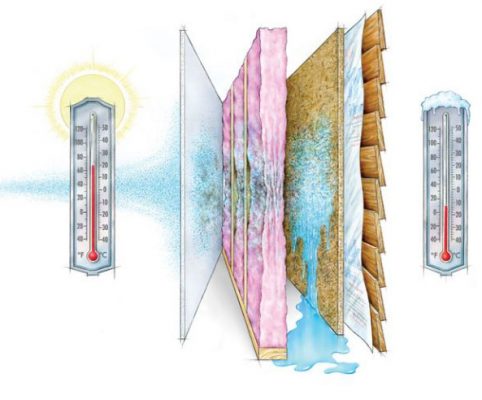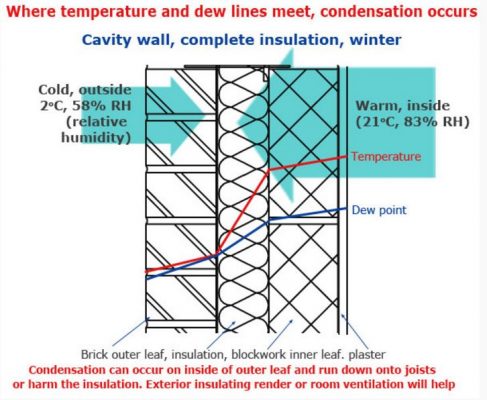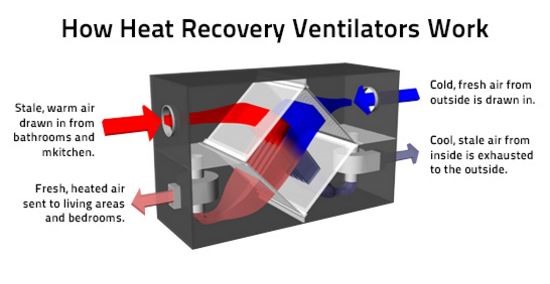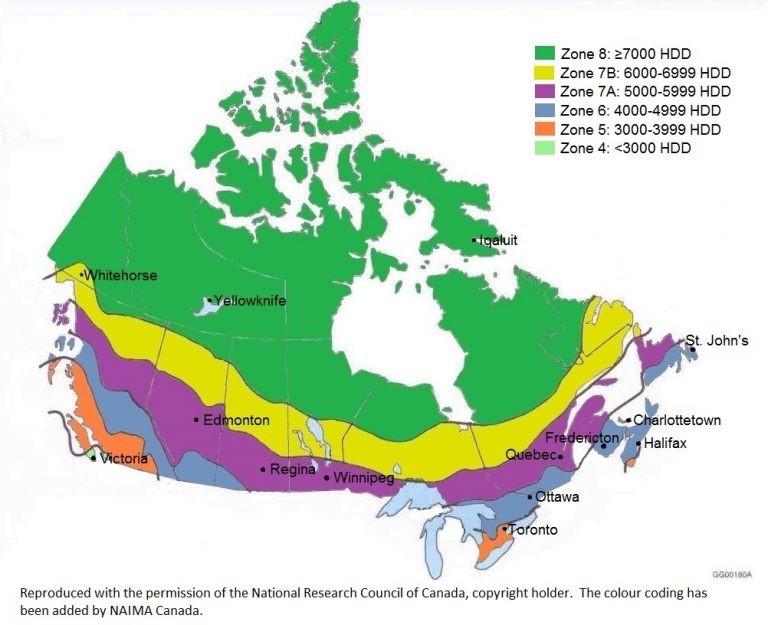♦This article is a refresh from one that Grant published on the Canadian Contractor, January 9, 2019.
Air sealing a building envelope is an important factor for energy efficiency and occupant comfort. A drafty room will feel cold in winter, even if the thermometer is set to 21C. Air leakage also contributes to high energy bills. However, as we insulate by packing greater amounts of insulation in the walls to respond to the increased demands for greater building performance, air sealing becomes more critical for two even more important factors — building durability and indoor air quality.
Why? It’s about water vapour. Air holds tiny water droplets called water vapour. The amount of water droplets a given volume of air can hold depends on temperature – the warmer the air, the more water vapour it can hold, and vice versa. At 100% relative humidity (RH), air is fully saturated with tiny water droplets relative to the air temperature. Warm up that air and the RH drops; cool that air, or allow the fully saturated air to come into contact with a surface cooler than the air, and water droplets will form. This is called condensation, or dew. The dew point of air is the temperature where the RH has reached 100%. Think about a cold coke can sitting outside on a hot summer day, how water droplets (condensation) forms on the outside of the can. A building acts the same way in the winter, like an inside-out coke can — hot and humid on the inside. In winter when it’s cold outside, condensation forms when warm moist indoor air makes contact with a cool surface. That cool surface could be the interior wall surface itself from a poorly insulated (highly conductive) assembly, or within the wall itself due to air movement (referred to as interstitial condensation; Figure 1) via unsealed wall penetrations. Vapour diffusion, which is the movement of water vapour through materials, can also cause interstitial condensation, albeit a factor much less than air movement. Condensation on windows demonstrates this quite visually for us (they can also act as unintentional dehumidifiers, who knew?). In summer the phenomenon is reversed with air-conditioned buildings, warm moist outdoor air, cool inside air.

How do we know if, or where, the dew point will occur? There are several ways. The most primitive is to analyze the wall section with a psychrometric chart, Figure 2, and trace the air’s relative humidity as it passes through the envelope assembly, Figure 3 (Doggart, 2012). Another method is use hygrothermal modelling such as WUFI. Chances are however, if the building is occupied (aren’t they all?) and you have air leakage (they all do, to some extent), you have a high risk of condensate forming*. That can lead to water staining, material deterioration, and mold – resulting in poor aesthetics, structural problems, and reduced indoor air quality, respectively. It is likely that interstitial condensation may be occurring without the occupants even realizing it.
*The greater the temperature gradient between the walls, the greater the interior humidity, the greater the air leakage, and the greater the amount of (air permeable) insulation, the greater the risk.


The function of the building can also be directly related to the root cause of condensation. Inhabitants produce water vapour through breathing, perspiring, showering, cooking, etc. The more water vapour produced, the greater the risk of condensation forming from a leaky building envelope. This can impact durability. A wise university professor once told me that the most durable building was a vacant building.
Older buildings (100+ years) were relatively drafty. They usually did not have a problem with condensation forming within the walls, because they were poorly insulated, often with not much more than a handful of old newspapers (they were also built out of old growth tree lumber that are very moisture resistant, but that’s for another topic). The lack of insulation allowed heat (also referred to as energy) to move across the envelope and dry it out. Those drafty envelopes also allowed the humid interior air to be quickly displaced by outside dry air during the winter months, thereby not allowing humidity levels to build up. Radiators were placed in front of windows and beside doors to blanket their surfaces with heat energy and convective air, thereby preventing condensate to form on its cold single pane glass. Today, it is still very typical to see heat registers and radiators at those locations, at least in all but the high-performance buildings – due to them being well insulated, with very good windows and doors, and … air tight!
How big of a problem is air leakage? This depends on the makeup of the building’s envelope. Some questions to consider:
- Thermal Bridging: Are there conductive materials such as concrete, aluminum, or steel bypassing the insulation layer? This will greatly increase the risk of cold surfaces/strikes and subsequently condensation. Even wood is a thermal bridge when next to batt insulation. Did you know thermal bridging is the number one cause of condensation and mold?
- Material Types: Are there moisture-sensitive materials such as wood or paper faced drywall that will degrade with moisture or promote bacterial growth within the building assembly?
- Insulation Types: Is the building solely insulated with fiberglass batt insulation without an effective air barrier or vapour retarder to prevent dew point from occurring within the wall? Or is the building wrapped with exterior rigid insulation so that moisture-rich air cannot reach dew point and therefore have no adverse effects?
A reason why we do not see more widespread problems with condensation and rot in walls is that building components can to some degree buffer some moisture until conditions change, allowing materials to dry out again. In Canada and the United States, we tend to construct our residential buildings with wood. Wood is a hygroscopic material, meaning that it can readily absorb and release moisture. Wood as a buffer will absorb moisture up until it hits saturation point, after which rot and mould growth can occur. Brick and stone mass walls can also do this, however if exposed to freezing temperatures, freeze thaw action can occur resulting in material breakdown.
Understanding the importance of air sealing along with the risks of interstitial condensation forming within walls is critical in designing highly insulated buildings. If it is not, the results could be disastrous leading to very expensive and disruptive repairs – and the related health consequences related to poor indoor air quality.
One last note about air sealing. From an energy perspective, its not just about the loss of heat energy. Its also about the loss and gain of humidity loads (also referred to as latent loads). In winter, interior moisture is lost to the exterior. People then compensate with humidifiers, which requires energy. Generally, a well sealed building should not need a humidifier as low air leakage will be offset by interior moisture loads. In summer, there’s an even greater energy penalty. Exterior moisture is gained to the interior. This requires additional air conditioning latent cooling and possibly dehumidification (a dehumidifier also adds heat load as part of its thermal dynamics). And as air conditioner units increase in energy efficiency, their latent cooling capacity actually decreases, resulting in even greater moisture loads to the building.
So now you know; air sealing is king.
References
- Doggart, J. (2012, October). Is Interstitial Condensation a Risk? Retrieved from Super Homes
- Gibson, S. (2010, August 17). Vapor Barriers Are a Good Thing, Right? Retrieved from Green Building Adviso




